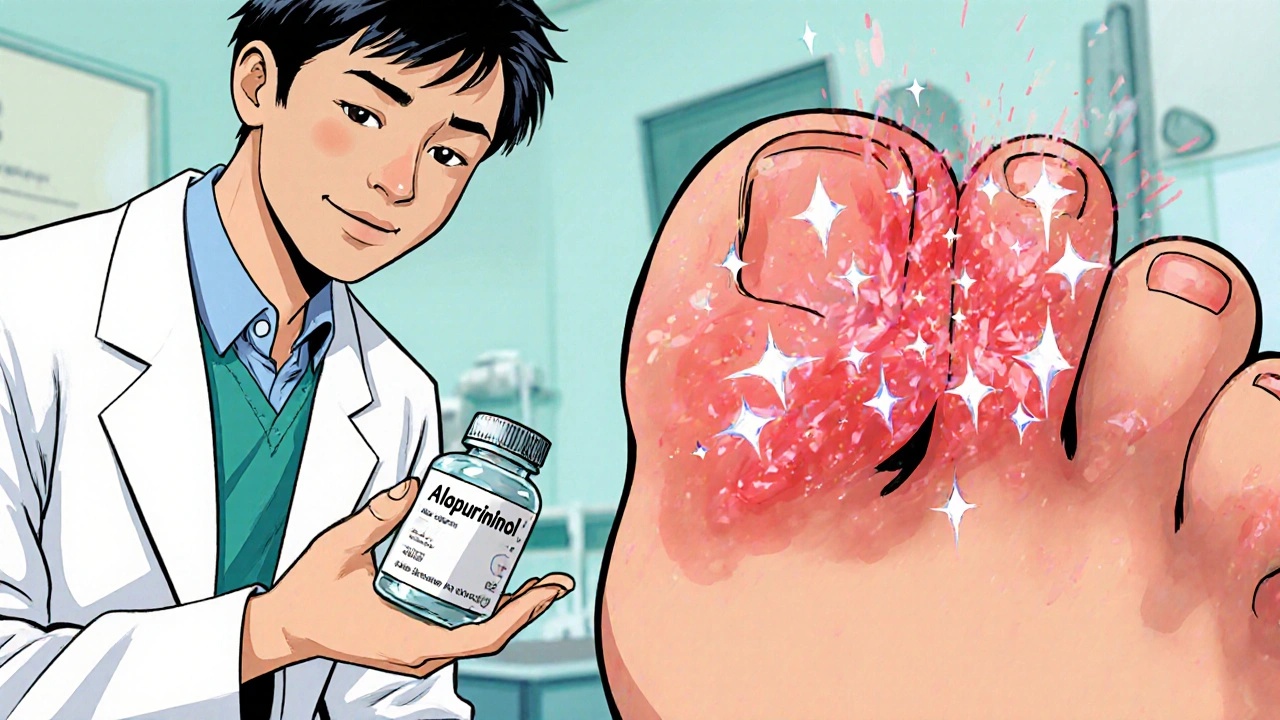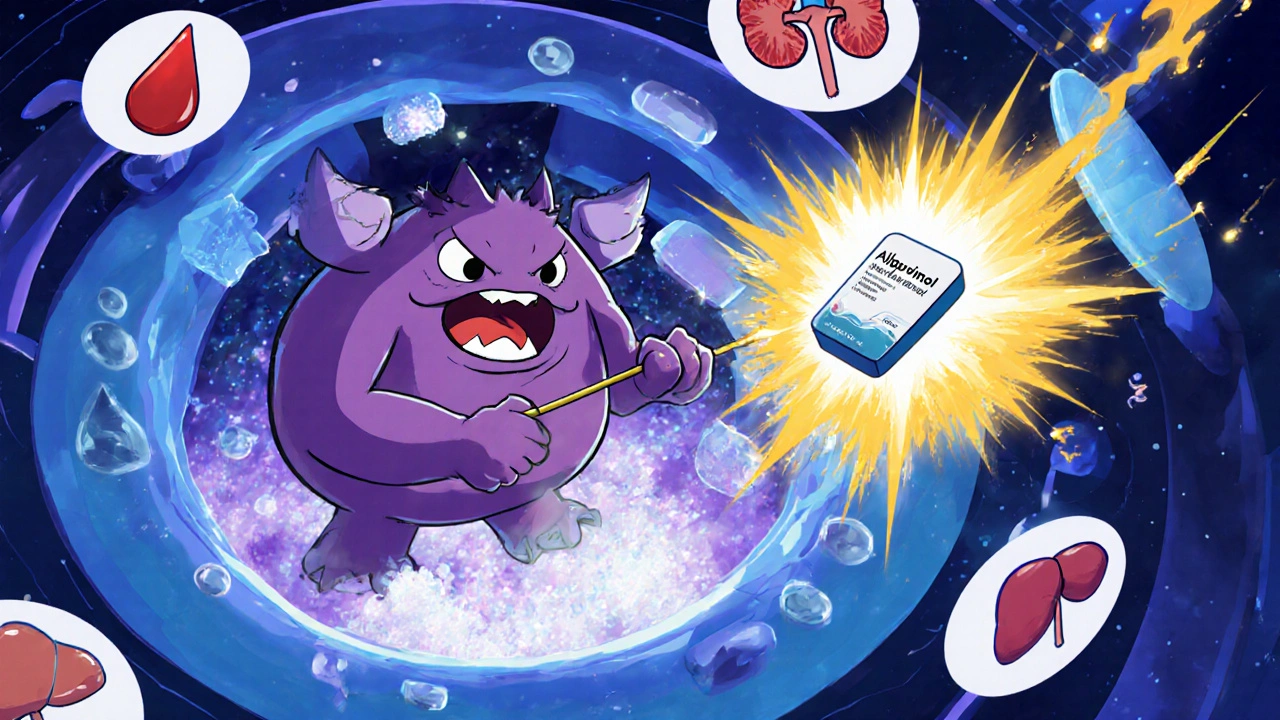Allopurinol and How It Stops Gout Flare-Ups
 Oct, 17 2025
Oct, 17 2025
Uric Acid Target Calculator
Based on clinical guidelines, uric acid levels above 6.8 mg/dL increase gout flare risk. This calculator shows if your level is within target range.
Enter your uric acid level to check if it's within target range
When doctors prescribe Allopurinol, they aim to lower uric acid levels and keep gout at bay.
Quick Takeaways
- Allopurinol blocks xanthine oxidase, the enzyme that makes most of your uric acid.
- Start low, go slow - typical dose 100mg/day, titrated up to 300mg or more.
- Check kidney function before you begin and every few months thereafter.
- Common side effects: rash, nausea, and rare but serious hypersensitivity.
- Combine with lifestyle changes - hydration, low‑purine diet, weight control.
Gout is a painful arthritis caused by crystal deposits of uric acid in joints. The condition flares when the blood level of uric acid (serum urate) spikes above its solubility point, usually around 6.8mg/dL. Over time, repetitive spikes lead to permanent crystal buildup and the classic red, hot, throbbing attacks.
Allopurinol is a xanthine oxidase inhibitor used to reduce uric acid production in patients with gout and hyperuricemia.
Gout is an inflammatory arthritis triggered by monosodium urate crystals that form when uric acid accumulates in the bloodstream.
Why Lowering Uric Acid Matters
Uric acid is the end product of purine metabolism. In most people, the kidneys filter and excrete it efficiently. When production outpaces excretion, levels rise, and the supersaturated fluid starts to precipitate. The resulting crystals irritate joint linings, causing the classic painful flare.
How Allopurinol Works
Allopurinol targets xanthine oxidase the enzyme that converts hypoxanthine to xanthine and then to uric acid
- By blocking this pathway, the drug cuts uric acid synthesis by up to 70%.
- Lower production lets the kidneys catch up, gradually pulling serum urate back into the target range (<5mg/dL for most patients).
- When uric acid stays below the solubility threshold, new crystal formation stops and existing crystals can dissolve.
Starting and Adjusting the Dose
- Baseline labs: serum creatinine, eGFR, complete blood count.
- Begin with 100mg once daily for most adults.
- Increase by 100mg every 2-4weeks until you reach the urate goal, usually 300mg/day.
- Patients with impaired kidney function may need a maximum of 200mg/day; dose is often calculated as 100mg per 10mL/min of eGFR.
- Check serum urate 4-6weeks after each dose change.
Never start at a high dose unless you’re a specialist managing refractory cases; rapid drops can precipitate a “tumor lysis‑like” reaction and trigger flares.
Monitoring Keys
Regular monitoring keeps the therapy safe and effective.
- Kidney function: eGFR every 3months during titration, then twice a year.
- Serum urate: aim <5mg/dL (or <6mg/dL if you cannot reach lower).
- Liver enzymes: check if you have pre‑existing liver disease.
- Complete blood count: watch for rare leukopenia.

Side Effects and Safety Concerns
Most people tolerate Allopurinol well, but be aware of the following:
- Rash or itching - common; stop the drug if the rash spreads.
- Nausea, mild headache, or dizziness - usually mild.
- Allopurinol hypersensitivity syndrome (AHS) - a serious, potentially fatal reaction that includes fever, rash, eosinophilia, and liver/kidney injury. The risk climbs with higher starting doses and in patients with chronic kidney disease.
- Interactions: avoid concurrent use with azathioprine or mercaptopurine without dose reduction; warfarin may need closer INR monitoring.
If you notice any sign of a severe rash or flu‑like symptoms, call your doctor immediately.
Allopurinol vs. Other Urate‑Lowering Options
| Medication | Mechanism | Typical Starting Dose | Renal Considerations | Notable Side Effects |
|---|---|---|---|---|
| Allopurinol | Xanthine oxidase inhibition | 100mg daily | Dose reduced if eGFR < 30mL/min | Rash, AHS, liver enzyme rise |
| Febuxostat | Selective xanthine oxidase inhibition | 40mg daily | Can be used in moderate renal impairment; caution in severe CKD | Cardiovascular risk signal, liver enzyme increase |
| Probenecid | Urate reabsorption blocker (renal) | 250mg twice daily | Requires good renal function (eGFR > 30mL/min) | Kidney stones, GI upset |
| Lesinurad | URAT1 inhibitor (combined with xanthine oxidase inhibitor) | 200mg daily + allopurinol/febuxostat | Same renal limits as the partner drug | Kidney injury, rash |
Allopurinol remains the first‑line choice for most patients because it is inexpensive, has a long safety record, and works well in chronic kidney disease when dose‑adjusted.
Integrating Lifestyle Measures
Medication does the heavy lifting, but diet and habits decide whether you stay flare‑free.
- Hydration: Aim for at least 2-3L of water daily to help the kidneys flush uric acid.
- Low‑purine foods: Cut back on red meat, organ meats, shellfish, and sugary beverages.
- Alcohol moderation: Beer and spirits raise uric acid; if you drink, keep it under 2standard drinks per week.
- Weight management: Losing 5-10% of body weight can lower serum urate by 0.5-1mg/dL.
- Medication timing: Take Allopurinol after meals to reduce stomach upset; avoid splitting doses unless instructed.
Managing an Acute Flare While on Allopurinol
Starting Allopurinol during an active gout attack can actually worsen the flare. If you’re already experiencing pain, doctors usually prescribe a short course of NSAIDs non‑steroidal anti‑inflammatory drugs such as ibuprofen or naproxen or colchicine to control the inflammation. Once the pain subsides, they add or titrate Allopurinol.

When Allopurinol Might Not Be Enough
About 20% of patients cannot achieve the target urate level with Allopurinol alone. In those cases:
- Switch to Febuxostat (especially if you have severe CKD).
- Add a uricosuric agent like Probenecid or Lesinurad.
- Consider combination therapy under specialist supervision.
Special Populations
- Elderly: Start at 50mg daily and titrate slowly; monitor renal function closely.
- Pregnant or breastfeeding: Allopurinol is Category C; weigh benefits against potential risks.
- Patients with HLA‑B*5801 allele: Higher risk of AHS; genetic testing is recommended for certain Asian populations.
Putting It All Together - A Practical Checklist
- Confirm diagnosis of gout (joint aspiration, crystal identification).
- Order baseline labs: serum urate, creatinine, eGFR, LFTs, CBC.
- Start Allopurinol 100mg daily, educate about rash risk.
- Schedule follow‑up in 4weeks to check urate and renal labs.
- Adjust dose by 100mg increments until target <5mg/dL.
- Implement lifestyle changes: water, diet, weight.
- Have rescue meds (NSAID or colchicine) on hand for breakthrough flares.
- Re‑evaluate yearly, especially if kidney function changes.
Frequently Asked Questions
How long does it take for Allopurinol to prevent flares?
Usually 4-6weeks after reaching the target urate level. You may still need an anti‑inflammatory for occasional breakthrough attacks.
Can I take Allopurinol with my blood pressure meds?
Yes, most antihypertensives are safe. However, avoid thiazide diuretics that raise uric acid unless the dose is adjusted.
What should I do if I develop a rash?
Stop Allopurinol immediately and contact your doctor. A mild rash may resolve, but any spreading or fever‑ish symptoms require urgent evaluation for AHS.
Is Allopurinol safe for people with kidney disease?
Yes, but the dose must be lowered based on eGFR. A typical maximum for eGFR <30mL/min is 200mg/day.
Do I need to keep taking Allopurinol for life?
Most patients stay on it indefinitely because stopping often causes urate rebound and new flares. Your doctor may re‑evaluate after several years if you’ve been flare‑free.

Nickolas Mark Ewald
October 17, 2025 AT 14:37Allopurinol can really help keep gout attacks down if you follow the dosing plan.
Winston Bar
October 22, 2025 AT 05:44Sure, the whole "start low, go slow" hype sounds like pharma talking points. In practice many people see little benefit and just end up with side effects. The drug may lower uric acid numbers, but it doesn't guarantee fewer flares for everyone. I’d say most patients are better off focusing on diet and weight control instead.
Russell Abelido
October 26, 2025 AT 14:17When you hear the term Allopurinol, imagine a quiet guardian standing between your bloodstream and the angry crystal storms that cause gout.
It sneaks into the biochemical highway and blocks xanthine oxidase, the mischievous enzyme that would otherwise crank up uric acid production.
By turning down that engine, the drug lets the kidneys play catch‑up, slowly draining the excess urate that would otherwise precipitate into painful shards.
The beauty of this mechanism is its elegance: you don’t need to chase every single dietary purine, you just calm the factory at its source.
Most patients start with a modest 100 mg dose, because the body loves a gentle invitation rather than a harsh command.
If tolerable, doctors can titrate upward, sometimes reaching 300 mg or more, always listening to the subtle whispers of kidney function tests.
Kidney labs are like the lighthouse in a foggy night, signaling when you’re safe to increase the dose or when you must pull back.
Side effects? A rash or a queasy stomach can appear, but the real nightmare is the rare hypersensitivity reaction that demands immediate cessation.
That’s why patients are advised to report any unusual symptoms the moment they appear, rather than waiting for the pain to mount.
Lifestyle tweaks-drinking plenty of water, trimming down on red meat, and maintaining a healthy weight-act as allies, amplifying the drug’s quiet power.
Think of Allopurinol as the steady drumbeat in a chaotic marching band, keeping the tempo slow enough that the crowd (your joints) stays calm.
When the serum urate finally dips below the solubility threshold of about 6.8 mg/dL, the crystal formation slows dramatically.
Over months, the existing crystal deposits can even dissolve, granting long‑term relief that feels like a sunrise after a long night.
Patients often describe the first few weeks as a period of adjustment, where the body learns a new rhythm, and patience becomes a virtue.
In the end, Allopurinol isn’t a miracle cure, but a dependable partner in the long fight against gout, opening the door to a life where spontaneous foot pain becomes a distant memory. :)
Miriam Rahel
October 30, 2025 AT 18:17From a pharmacological perspective, Allopurinol operates as a reversible competitive inhibitor of xanthine oxidase, thereby attenuating the conversion of hypoxanthine to uric acid. The dosage titration protocol-commencing at 100 mg daily and potentially escalating to 300 mg or beyond-is predicated upon serial assessment of serum urate and renal clearance. It is imperative to obtain baseline and periodic creatinine measurements, as impaired renal function necessitates dose modification to avert accumulation and toxicity. While adverse reactions such as maculopapular rash are documented, the incidence of severe hypersensitivity syndrome remains low but warrants vigilance. Consequently, the therapeutic regimen should be individualized, integrating both laboratory parameters and patient tolerance.
Samantha Oldrid
November 3, 2025 AT 16:44Oh great, another “magic pill” for gout. As if pharma hasn’t already tried to sell us a cure for everything.
Malia Rivera
November 7, 2025 AT 09:37Listen, this is not just about a drug; it’s about taking back control of our bodies from a global pharma agenda that wants us dependent on endless prescriptions. Allopurinol, when used correctly, can be a shield against the tyranny of gout attacks, but only if we pair it with good old‑fashioned American common sense-stay active, eat right, and demand transparency from our doctors.
lisa howard
November 10, 2025 AT 20:57Picture this: a humble tablet slipping into the bloodstream, embarking on a heroic quest to battle the relentless armies of uric acid crystals that have besieged the joints for years, each dose a strategic maneuver in a grand campaign of biochemical warfare; the patient, poised on the precipice of hope, watches as the serum urate levels slowly, inexorably decline, like the tide receding from a storm‑tossed shore, revealing the hidden treasures of pain‑free movement that were once obscured by the fog of inflammation, all while the physician, armed with lab results and an unwavering resolve, calibrates the dosage with the precision of a maestro conducting a symphony, ensuring that the rhythm of kidney function remains harmonious and the dreaded hypersensitivity specter stays forever banished from the narrative of recovery.
Cindy Thomas
November 14, 2025 AT 02:44While Allopurinol does its part in lowering uric acid, it’s essential to remember that it’s not a standalone miracle. Combining the medication with proper hydration, dietary adjustments, and regular monitoring provides the best chance at long‑term relief. :)
Kate Marr
November 17, 2025 AT 02:57Allopurinol works, plain and simple. 🇺🇸